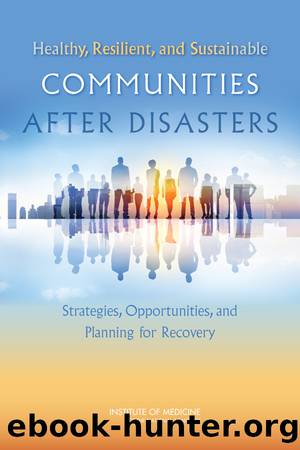Healthy, Resilient, and Sustainable Communities After Disasters: Strategies, Opportunities, and Planning for Recovery by Committee on Post-Disaster Recovery of a Community’s Public Health Medical & Social Services

Author:Committee on Post-Disaster Recovery of a Community’s Public Health, Medical & Social Services
Language: eng
Format: epub
Tags: ebook, book
Publisher: The National Academies Press
Published: 2015-09-10T00:00:00+00:00
7
Behavioral Health
Behavioral health1 problems and disorders are among the most frequent adverse health effects after exposure to a disasterâthis despite chronic underreporting due to the stigma often associated with these conditions, the lack of visible or physical wounds, the separation of mental health services from medical services, and the lag time between exposure and the onset of disorder. Almost everyone in a community struck by a disaster will feel some type of emotional effect. For most, the acute reactions will be transient, and functional recovery will occur without intervention. For some, however, the impacts of a disaster on behavioral health can be severe and long-lasting, and if not addressed, can impede the recovery of individuals, families, and communities, resulting in significant long-term health burdens. Consequently, it is critically important to identify those individuals at risk for more severe and persistent psychopathology after a disaster and link them with the appropriate preventive and/or rehabilitative services. To this end, however, significant pre-disaster planning is required to establish clear roles and responsibilities for the myriad stakeholders at all levels, an agile and resilient system for delivery of behavioral health services, and a process for evaluating the needs for those services and ensuring that those in need are receiving timely and effective treatment. Where such conditions do not exist in advance, the disaster recovery process can represent an opportunity for advancing toward that more optimal state.
This chapter examines the linkages among behavioral health, resilience, and healthy communities; activities that mitigate adverse behavioral health effects in survivors; the gaps in the current system for addressing disaster-related behavioral health needs; and the opportunities for strengthening the behavioral health sector and integrating it with other sectors by leveraging disaster-related resources and experiences. Based on documented expert consensus on the important elements of behavioral health interventions (Watson et al., 2011, p. 485), the committee proposes the following key recovery strategies for the behavioral health sector that should cut across all phases of the disaster cycle and that represent recurring themes throughout this chapter:
Integrate behavioral health activities and programming into other sectors (e.g., education, health care, social services) to reduce stand-alone services, reach more people, foster resilience and sustainability, and reduce stigma.
Provide a spectrum of behavioral health services and use an approach based on stepped care (from supportive intervention to long-term treatment).
Maximize the participation of the local affected population in recovery planning with respect to behavioral health, and identify and build on available resources and local capacities and networks (community, families, schools, and friends) in developing recovery strategies.
Promote a sense of safety, connectedness, calming, hope, and efficacy at the individual, family, and community levels.
Download
This site does not store any files on its server. We only index and link to content provided by other sites. Please contact the content providers to delete copyright contents if any and email us, we'll remove relevant links or contents immediately.
Cecilia; Or, Memoirs of an Heiress — Volume 1 by Fanny Burney(31351)
Cecilia; Or, Memoirs of an Heiress — Volume 3 by Fanny Burney(30949)
Cecilia; Or, Memoirs of an Heiress — Volume 2 by Fanny Burney(30907)
The Great Music City by Andrea Baker(21572)
We're Going to Need More Wine by Gabrielle Union(18085)
Bombshells: Glamour Girls of a Lifetime by Sullivan Steve(13119)
Pimp by Iceberg Slim(12946)
All the Missing Girls by Megan Miranda(12774)
Fifty Shades Freed by E L James(12463)
Talking to Strangers by Malcolm Gladwell(11906)
Norse Mythology by Gaiman Neil(11901)
Crazy Rich Asians by Kevin Kwan(8369)
Mindhunter: Inside the FBI's Elite Serial Crime Unit by John E. Douglas & Mark Olshaker(7849)
The Lost Art of Listening by Michael P. Nichols(6481)
Enlightenment Now: The Case for Reason, Science, Humanism, and Progress by Steven Pinker(6414)
Bad Blood by John Carreyrou(5781)
The Four Agreements by Don Miguel Ruiz(5531)
Weapons of Math Destruction by Cathy O'Neil(5046)
We Need to Talk by Celeste Headlee(4879)
